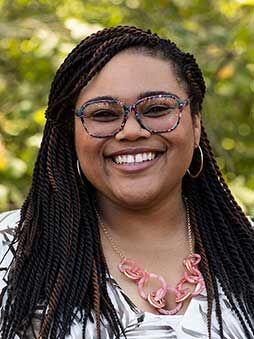Bias
Catching One's Breath in the Age of "I Can’t Breathe"
Coping during a dual pandemic of COVID and systemic injustice.
Posted May 24, 2021 Reviewed by Devon Frye
COVID-19 has created hardships for everyone; however, it has disproportionately affected marginalized communities. In this two-part interview, Dr. Amber Nelson discusses the psychological fatigue many communities of color are experiencing in the midst of this dual pandemic of COVID and continued systemic injustice.

Dr. Amber L. Nelson (she/her) is an assistant professor of clinical psychology in the Psy.D. program at George Fox University. Dr. Nelson currently serves as the Director of Primary Care and the Director of Equity and Inclusion for the department. She clinically specializes in pediatric psychology with an emphasis on health disparities, specifically in Cystic Fibrosis and Sickle Cell Disease. She identifies as an inclusion and justice-oriented scholar-practitioner.
This is Part 1 of a two-part interview with Dr. Amber Nelson; you can find Part 2 of this series, along with all other Hope + Resilience posts, here.
Jamie Aten: What has this season during the pandemic been like for you?
Amber Nelson: I. Am. Tired. I am so tired. I’ve been fatigued and even exhausted, but I have never experienced anything like this before.
And I am not alone—some version of the above statement has recently become the most common response when asked the question, “How are you?” In the midst of a global health crisis, this sentiment to a previously innocuous inquiry is now all but universal. We have entered and surpassed what Brene Brown has called, “collective weariness.” The sustained impact of grief, isolation, and financial uncertainty has without a doubt impacted us all.
Yet given the added layers of increased racial violence, racial trauma, "racial battle fatigue"—a term coined by University of Utah professor William A. Smith that refers to the physical and psychological symptoms that result from frequent exposure to racism—and the disproportionate impact of COVID on marginalized communities, the experience of fatigue and loss in communities of color is demonstrably different; it is gripping.
JA: The pandemic has been a prevalent stressor during this season. But while it's been unfolding, systematic racial injustice has only continued to target marginalized communities. Can you speak to how this has added to the exhaustion?
AN: The last words of George Floyd, an unarmed black man killed by former police officer Derek Chauvin, were those of desperation, a primal instinct calling out to his mother, and an exclamation; “I can’t breathe!” In the eyes of many observers, these words not only served as his last disconsolate cry for help but as an indictment of the ongoing systemic oppression inflicted on BIPOC and marginalized communities of color. They have become a kind of anthem of this moment—an unfortunate battle cry: “I can’t breathe!”
While there is a long history of racial tension, oppression, and systemic racism, the current climate change began to gain momentum in 2016 with the rise of the Black Lives Matter movement (BLM); it has gained more attention and action in this last year. Just two months into quarantine in May 2020, there was a flurry of incidents that started with the reminder of Breonna Taylor’s death; witnessing Ahmaud Arbery’s murder; seeing the police called on Christian Cooper while he birdwatched, potentially threatening his life; and George Floyd’s murder at the hands of police officers. The nature of these incidents—which occurred during a unique time in history, when the world was all but stopped and everyone was forced to slow down—resulted in an eruption of emotion and calls to action.
It is important to note that racialized trauma and violence are not only experienced by the Black community. In the past year, we have also seen a rise in Anti-Asian hate crimes, like that of the recent Atlanta shooting that resulted in the murder of six women of Asian descent. Xenophobic rhetoric such as “Kung Flu” or the “Chinese Virus” has run rampant. Physical attacks—often accompanied by racist remarks like “You are infected,” “Go back to China,” or “You’re the one who brought the virus here”—continue to plague the Asian community.
And more recently, we saw videos of young Adam Toledo (13), a Mexican-American boy shot and killed by police; Lieutenant Caron Nazario, a black Latino Army officer pepper-sprayed and held at gunpoint by police; and Daunte Wright (20) a black biracial young man killed by police. Both Nazario and Wright were stopped for traffic violations.
JA: How has the pandemic affected marginalized communities in light of systemic injustice, forming the notion of the “dual pandemic” you mentioned?
AN: In the midst of this, we are in a global health pandemic that is also disproportionately impacting people of color. According to the CDC, American Indian and Alaskan Native individuals have 2.8x the number of cases, are 5.3x likely to be hospitalized, and have 1.4x the death rate. Hispanic and Latinx individuals have 2.8x the cases, 4.6x the number of hospitalizations, and have a 1.1x higher death rate. And finally, Black and African American Individuals have 2.6x the cases, 4.7x the number of hospitalizations, and 2.1x the death rate.
There are ongoing issues of discrimination and access to care in the First Nations and Latinx populations that are unfolding alongside continued re-exposure to trauma. As each week passes, more news comes out about attacks against marginalized communities, resulting in debate, dissent, and in many cases, dismissal of the community's pain. As the pressures of grief, loss, health, collective trauma, re-traumatization, racial battle fatigue, and feeling unsafe wherever one goes mount, it has become seemingly impossible for many people of color, myself included, to find a space that we aren’t reminded of the weight pressing on our necks.
As a result, we have entered into a time that the president of the American Psychological Association called a "racism pandemic"; and for many in BIPOC communities, it is a dual pandemic of epic proportions. If the dominant experience of this dual pandemic is feeling like you can’t breathe, then finding hope and resilience, or at the very least coping and safety, is not only an act of resistance—it is a way to finally catch your breath.
Check back tomorrow for Part 2 of this series, along with all other Hope + Resilience posts, here.




